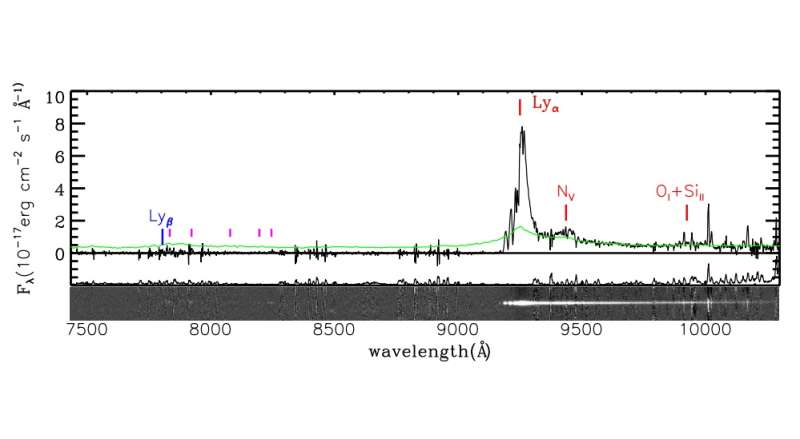December 21, 2016 report
High-redshift quasar discovered by Pan-STARRS

(Phys.org)—A new luminous high-redshift quasar has been detected by one of the telescopes of the Panoramic Survey Telescope and Rapid Response System (Pan-STARRS). The newly discovered quasi-stellar object received designation PSO J006.1240+39.2219 and is the seventh highest redshift quasar known to date. The findings are presented in a paper published Dec. 19 on arXiv.org.
Quasars are supermassive black holes with accretion disks in the center of a galaxy. Their redshifts are measured from the strong spectral lines that dominate their visible and ultraviolet spectra. These lines are brighter than the continuous spectrum, so they are called 'emission' lines. All observed quasar spectra have redshifts between 0.056 and 7.085.
Quasars with high redshift (over 6.0) are of special interest for astronomers because their ultraviolet light is absorbed by the neutral hydrogen along the line of sight; thus, they can be used to probe the intergalactic medium in the early universe. They are the most luminous and most distant, compact objects in the observable universe. Their spectrum can be used to estimate the mass of a supermassive black hole, which constrains the evolution and formation model of a quasar. Therefore, high-redshift quasars could serve as a powerful tool to probe the early universe.
Recently, a team of researchers led by Ji-Jia Tang of the National Taiwan University in Taipei, Taiwan, has searched for such quasars using the first Pan-STARRS telescope (PS1) located in Hawaii. In particular, they tried to find red-color objects between two adjacent broad bands caused by the strong intergalactic medium absorption on the blue side of the redshifted Lyman-alpha line emission.
They detected a new luminous high-redshift quasar at redshift of 6.61. The discovery was later confirmed by the team during a follow-up observation campaign carried out with the Subaru Faint Object Camera and Spectrograph (FOCAS) mounted on the Subaru Telescope in Hawaii.
According to the paper, PSO J006.1240+39.2219, besides being the seventh highest redshift quasar known to date, is also one of nine quasars above the redshift of 6.5.
"We report a discovery of a new quasar at z 6.6 select from PS1 with a spectroscopic confirmation. This is the seventh highest quasar among nine z-dropout quasar (z>6.5) known to date," the paper reads.
The researchers found that the rest-frame ultraviolet luminosity of PSO J006.1240+39.2219 is comparable to other z-dropout quasars, though its Lyman-alpha line emission is much stronger when compared to typical quasars obtained from low redshift.
"J006.1240+39.2219 is consistent with other comparably distant quasars, although it has much stronger Lyman-alpha line. (…) The spectral resolution is adjusted to match for a fair comparison. This shows that Lyman-alpha line emission of PSO J006.1240+39.2219 is much stronger than those quasars at low redshifts," the astronomers wrote.
The team also noted that after decades of searching, more than 100 quasars were found with redshifts between 5.7 and 6.5 from various kind of surveys. So far, ULAS J112001.48+064124 is the highest redshift quasar with a redshift of 7.085. It was found in 2011 using UK Infrared Telescope (UKIRT) Infrared Deep Sky Survey (UKIDSS).
More information: A Quasar Discovered at redshift 6.6 from Pan-STARRS1, arXiv:1612.06148 [astro-ph.GA] arxiv.org/abs/1612.06148
Abstract
Luminous high-redshift quasars can be used to probe of the intergalactic medium (IGM) in the early universe because their UV light is absorbed by the neutral hydrogen along the line of sight. They help us to measure the neutral hydrogen fraction of the high-z universe, shedding light on the end of reionization epoch. In this paper, we present a discovery of a new quasar (PSO J006.1240+39.2219) at redshift z = 6.61 +- 0.02 from Panoramic Survey Telescope & Rapid Response System 1. Including this quasar, there are nine quasars above z > 6.5 up to date. The estimated continuum brightness is M1450= 25.96 +- 0.08. PSO J006.1240+39.2219 has a strong Ly alpha emission compared with typical low-redshift quasars, but the measured near-zone region size is RNZ = 3.2 +- 1.1 proper megaparsecs, which is consistent with other quasars at z~6.
© 2016 Phys.org


















